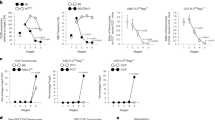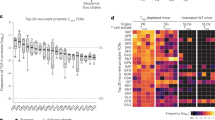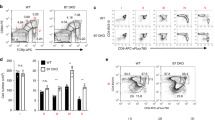Abstract
Interleukin 2 signaling is believed to be critically involved in several aspects of CD25+ CD4+ regulatory T cell biology, such as intrathymic development, peripheral survival and suppressive function. Here we have analyzed the effects of interleukin 2 or CD25 deficiency on agonist-driven thymic development and the peripheral homeostasis of an antigen-specific population of regulatory T cells positive for forkhead family transcription factor Foxp3 and have correlated our observations with polyclonal suppressor populations. We found that the differentiation, acquisition of functional capacity and formation of a sizeable pool of suppressor T cells in the thymus was independent of interleukin 2 signaling, but that interleukin 2 was essential for the survival of mature Foxp3+ regulatory T cells.
This is a preview of subscription content, access via your institution
Access options
Subscribe to this journal
Receive 12 print issues and online access
$209.00 per year
only $17.42 per issue
Buy this article
- Purchase on Springer Link
- Instant access to full article PDF
Prices may be subject to local taxes which are calculated during checkout







Similar content being viewed by others
References
Schorle, H., Holtschke, T., Hunig, T., Schimpl, A. & Horak, I. Development and function of T cells in mice rendered interleukin-2 deficient by gene targeting. Nature 352, 621–624 (1991).
Suzuki, H. et al. Deregulated T cell activation and autoimmunity in mice lacking interleukin-2 receptor β. Science 268, 1472–1476 (1995).
Willerford, D.M. et al. Interleukin-2 receptor α chain regulates the size and content of the peripheral lymphoid compartment. Immunity 3, 521–530 (1995).
Sadlack, B. et al. Ulcerative colitis-like disease in mice with a disrupted interleukin-2 gene. Cell 75, 253–261 (1993).
Suzuki, H., Zhou, Y.W., Kato, M., Mak, T.W. & Nakashima, I. Normal regulatory α/β T cells effectively eliminate abnormally activated T cells lacking the interleukin 2 receptor β in vivo. J. Exp. Med. 190, 1561–1572 (1999).
Kramer, S., Schimpl, A. & Hunig, T. Immunopathology of interleukin (IL) 2-deficient mice: thymus dependence and suppression by thymus-dependent cells with an intact IL-2 gene. J. Exp. Med. 182, 1769–1776 (1995).
Almeida, A.R., Legrand, N., Papiernik, M. & Freitas, A.A. Homeostasis of peripheral CD4+ T cells: IL-2Rα and IL-2 shape a population of regulatory cells that controls CD4+ T cell numbers. J. Immunol. 169, 4850–4860 (2002).
Roncarolo, M.G., Bacchetta, R., Bordignon, C., Narula, S. & Levings, M.K. Type 1 T regulatory cells. Immunol. Rev. 182, 68–79 (2001).
Weiner, H.L. Induction and mechanism of action of transforming growth factor-β-secreting Th3 regulatory cells. Immunol. Rev. 182, 207–214 (2001).
Shevach, E.M. CD4+CD25+ suppressor T cells: more questions than answers. Nat. Rev. Immunol. 2, 389–400 (2002).
Sakaguchi, S. Naturally arising CD4+ regulatory T cells for immunologic self-tolerance and negative control of immune responses. Annu. Rev. Immunol. 22, 531–562 (2004).
Papiernik, M., de Moraes, M.L., Pontoux, C., Vasseur, F. & Penit, C. Regulatory CD4 T cells: expression of IL-2Rα chain, resistance to clonal deletion and IL-2 dependency. Int. Immunol. 10, 371–378 (1998).
Itoh, M. et al. Thymus and autoimmunity: production of CD25+CD4+ naturally anergic and suppressive T cells as a key function of the thymus in maintaining immunologic self-tolerance. J. Immunol. 162, 5317–5326 (1999).
Klein, L., Khazaie, K. & von Boehmer, H. In vivo dynamics of antigen-specific regulatory T cells not predicted from behavior in vitro. Proc. Natl. Acad. Sci. USA 100, 8886–8891 (2003).
Walker, L.S., Chodos, A., Eggena, M., Dooms, H. & Abbas, A.K. Antigen-dependent proliferation of CD4+CD25+ regulatory T cells in vivo. J. Exp. Med. 198, 249–258 (2003).
Apostolou, I., Sarukhan, A., Klein, L. & von Boehmer, H. Origin of regulatory T cells with known specificity for antigen. Nat. Immunol. 3, 756–763 (2002).
Jordan, M.S. et al. Thymic selection of CD4+CD25+ regulatory T cells induced by an agonist self-peptide. Nat. Immunol. 2, 301–306 (2001).
Malek, T.R., Yu, A., Vincek, V., Scibelli, P. & Kong, L. CD4 regulatory T cells prevent lethal autoimmunity in IL-2Rβ-deficient mice. Implications for the nonredundant function of IL-2. Immunity 17, 167–178 (2002).
Di Santo, J.P. & Rodewald, H.R. In vivo roles of receptor tyrosine kinases and cytokine receptors in early thymocyte development. Curr. Opin. Immunol. 10, 196–207 (1998).
Thornton, A.M., Donovan, E.E., Piccirillo, C.A. & Shevach, E.M. Cutting edge: IL-2 is critically required for the in vitro activation of CD4+CD25+ T cell suppressor function. J. Immunol. 172, 6519–6523 (2004).
de la Rosa, M., Rutz, S., Dorninger, H. & Scheffold, A. Interleukin-2 is essential for CD4+CD25+ regulatory T cell function. Eur. J. Immunol. 34, 2480–2488 (2004).
Malek, T.R., Porter, B.O., Codias, E.K., Scibelli, P. & Yu, A. Normal lymphoid homeostasis and lack of lethal autoimmunity in mice containing mature T cells with severely impaired IL-2 receptors. J. Immunol. 164, 2905–2914 (2000).
Furtado, G.C. et al. Regulatory T cells in spontaneous autoimmune encephalomyelitis. Immunol. Rev. 182, 122–134 (2001).
Furtado, G.C., Curotto de Lafaille, M.A., Kutchukhidze, N. & Lafaille, J.J. Interleukin 2 signaling is required for CD4+ regulatory T cell function. J. Exp. Med. 196, 851–857 (2002).
Setoguchi, R., Hori, S., Takahashi, T. & Sakaguchi, S. Homeostatic maintenance of natural Foxp3+CD25+CD4+ regulatory T cells by interleukin (IL)-2 and induction of autoimmune disease by IL-2 neutralization. J. Exp. Med. 201, 723–735 (2005).
Bayer, A.L., Yu, A., Adeegbe, D. & Malek, T.R. Essential role for interleukin-2 for CD4+CD25+ T regulatory cell development during the neonatal period. J. Exp. Med. 201, 769–777 (2005).
Curotto de Lafaille, M.A., Lino, A.C., Kutchukhidze, N. & Lafaille, J.J. CD25− T cells generate CD25+Foxp3+ regulatory T cells by peripheral expansion. J. Immunol. 173, 7259–7268 (2004).
Malek, T.R. The main function of IL-2 is to promote the development of T regulatory cells. J. Leukoc. Biol. 74, 961–965 (2003).
Hori, S., Nomura, T. & Sakaguchi, S. Control of regulatory T cell development by the transcription factor Foxp3. Science 299, 1057–1061 (2003).
Fontenot, J.D., Gavin, M.A. & Rudensky, A.Y. Foxp3 programs the development and function of CD4+CD25+ regulatory T cells. Nat. Immunol. 4, 330–336 (2003).
Khattri, R., Cox, T., Yasayko, S.A. & Ramsdell, F. An essential role for Scurfin in CD4+CD25+ T regulatory cells. Nat. Immunol. 4, 337–342 (2003).
Kirberg, J. et al. Thymic selection of CD8+ single positive cells with a class II major histocompatibility complex-restricted receptor. J. Exp. Med. 180, 25–34 (1994).
van Santen, H.M., Benoist, C. & Mathis, D. Number of T reg cells that differentiate does not increase upon encounter of agonist ligand on thymic epithelial cells. J. Exp. Med. 200, 1221–1230 (2004).
Apostolou, I. & von Boehmer, H. In vivo instruction of suppressor commitment in naive T cells. J. Exp. Med. 199, 1401–1408 (2004).
Liang, S. et al. Conversion of CD4+CD25− cells into CD4+CD25+ regulatory T cells in vivo requires B7 costimulation, but not the thymus. J. Exp. Med. 201, 127–137 (2005).
Hori, S., Haury, M., Lafaille, J.J., Demengeot, J. & Coutinho, A. Peripheral expansion of thymus-derived regulatory cells in anti-myelin basic protein T cell receptor transgenic mice. Eur. J. Immunol. 32, 3729–3735 (2002).
Thornton, A.M., Piccirillo, C.A. & Shevach, E.M. Activation requirements for the induction of CD4+CD25+ T cell suppressor function. Eur. J. Immunol. 34, 366–376 (2004).
Bensinger, S.J. et al. Distinct IL-2 receptor signaling pattern in CD4+CD25+ regulatory T cells. J. Immunol. 172, 5287–5296 (2004).
Hori, S. & Sakaguchi, S. Foxp3: a critical regulator of the development and function of regulatory T cells. Microbes Infect. 6, 745–751 (2004).
Acknowledgements
We thank H. von Boehmer (Dana Farber Cancer Institute, Boston, Massachusetts) for TCR-HA × pgk-HA mice and for discussions. Supported by Boehringer Ingelheim (Research Institute of Molecular Pathology), the Austrian National Science Fund (Sonderforschungsbereich F023 and Z58-B01) and the European Union (FP6 Integrated Project Eurothymaide).
Author information
Authors and Affiliations
Corresponding author
Ethics declarations
Competing interests
The authors declare no competing financial interests.
Supplementary information
Supplementary Fig. 1
CD25+Foxp3+ Treg are greatly reduced in the periphery of IL-2 deficient mice. (PDF 483 kb)
Supplementary Fig. 2
Phenotype of lymph node cells in Il2ra−/− TCR-HA × pgk-HA mice. (PDF 742 kb)
Rights and permissions
About this article
Cite this article
D'Cruz, L., Klein, L. Development and function of agonist-induced CD25+Foxp3+ regulatory T cells in the absence of interleukin 2 signaling. Nat Immunol 6, 1152–1159 (2005). https://doi.org/10.1038/ni1264
Received:
Accepted:
Published:
Issue Date:
DOI: https://doi.org/10.1038/ni1264
This article is cited by
-
IL-2 immunotherapy for targeting regulatory T cells in autoimmunity
Genes & Immunity (2023)
-
Costimulation blockade in combination with IL-2 permits regulatory T cell sparing immunomodulation that inhibits autoimmunity
Nature Communications (2022)
-
Efficient IL-2R signaling differentially affects the stability, function, and composition of the regulatory T-cell pool
Cellular & Molecular Immunology (2021)
-
Cytokines that target immune killer cells against tumors
Cellular & Molecular Immunology (2020)
-
CCR2 enhances CD25 expression by FoxP3+ regulatory T cells and regulates their abundance independently of chemotaxis and CCR2+ myeloid cells
Cellular & Molecular Immunology (2020)



